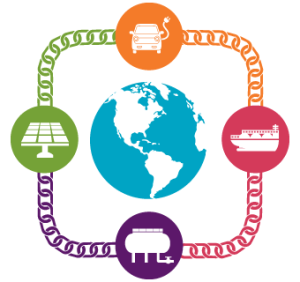By David L. Wochner, Sandra E. Safro, William M. Keyser, Molly Suda, Michael L. O’Neill, Jennifer L. Bruneau, Benjamin L. Tejblum, Elizabeth P. Trinkle and Gillian R. Giannetti
On August 3, 2017, the U.S. Senate confirmed President Trump’s nominations of Neil Chatterjee and Robert Powelson as Federal Energy Regulatory Commission (FERC) Commissioners and restored FERC’s quorum for the first time in nearly 180 days. The next step is for Mr. Chatterjee and Mr. Powelson to be sworn into their positions.
FERC has not had a quorum since February 3, 2017. In the interim, the Commission has accumulated a backlog of filings that will require formal Commission action, including
- Applications under Section 4 of the Natural Gas Act (NGA) related to the rates and terms and conditions of service;
- Applications related to interstate natural gas pipeline infrastructure under Section 7 of the NGA;
- Applications related to the rates and terms and conditions of service for interstate oil and products pipelines under the Interstate Commerce Act;
- Applications related to rates, rules, or charges for the transmission or wholesale sale of electric energy under the Federal Power Act;
- Complaints challenging rates, rules, or charges for the transmission or wholesale sale of electric energy under the Federal Power Act; and
- Petitions for declaratory orders seeking clarification from the Commission.
With FERC’s quorum restored, it also can move forward with rulemaking proceedings, including notices of proposed rulemaking that were issued before February 2017, as well as formal investigations and enforcement actions that require Commission authorization. It is unclear at this point how FERC will process and prioritize this backlog and how long it will take before the Commission is able to process filings on more traditional timeframes.
FERC does not hold a formal Commission meeting in August, but the Commissioners can vote notationally and therefore could begin issuing orders in the near term.
Below is a brief biography of FERC’s newest members.
Neil Chatterjee
Mr. Chatterjee most recently served as Senate Majority Leader Mitch McConnell (R-KY)’s senior energy policy analyst. While in this position, Mr. Chatterjee advised Senator McConnell on energy and infrastructure initiatives, including President Obama’s Clean Power Plan. Mr. Chatterjee worked previously as a Principal in Government Relations for the National Rural Cooperative Association and as an aide to House Republican Conference chairman Deborah Pryce (R-OH). Mr. Chatterjee grew up in Lexington, Kentucky near the heart of the coal industry. He earned his bachelor’s degree from St. Lawrence University in New York and a law degree from the University of Cincinnati. Mr. Chatterjee’s term expires on June 30, 2021.
Robert Powelson
Mr. Powelson has extensive regulatory experience, having served as a Commissioner at the Pennsylvania Public Utility Commission (PUC) and as President of the National Association of Regulatory Utility Commissioners. Mr. Powelson has served on numerous academic boards, including Drexel University’s Board of Trustees and Lincoln University’s Board of Directors. Prior to his position on the Pennsylvania PUC, Mr. Powelson worked as Chief Executive Officer and President of the Chester County, Pennsylvania Chamber of Business and Industry. He earned his bachelor’s degree from St. Joseph’s University and a master’s in government administration from the University of Pennsylvania. Mr. Powelson’s term expires on June 30, 2020.
In addition, the U.S. Senate Energy and Natural Resources Committee has scheduled a hearing for President Trump’s two other nominees, Richard Glick and Kevin McIntyre, for September 7, 2017, at 10 a.m. If approved by the Committee, Mr. Glick and Mr. McIntyre will then be ready to be scheduled for full Senate confirmation. Below is a brief biography for both nominees.
Richard Glick
Before President Trump nominated him for FERC, Mr. Glick served as General Counsel for the Democrats on the Senate Energy and Natural Resources Committee. Previously, Mr. Glick served as an energy and wind power lobbyist and advised U.S. Department of Energy Secretary Bill Richardson during the Clinton Administration. Mr. Glick earned his bachelor’s degree from The George Washington University and his law degree from the Georgetown University Law Center. If confirmed, Mr. Glick’s term would expire on June 30, 2022.
Kevin McIntyre
Mr. McIntyre is well-known among industry professionals, having served as co-head of Jones Day’s energy practice. While in private practice, Mr. McIntyre focused on government regulation of energy markets, electric and natural gas utilities, oil and natural gas pipelines, and co-authored several treatises on energy practice. Mr. McIntyre is actively involved in the Energy Bar Association, having served as on its Charitable Foundation’s Board of Directors. He also has served on the advisory board of Georgetown University Law Center’s Corporate Counsel Institute. Mr. McIntyre earned his bachelor’s degree from San Diego State University and his law degree from the Georgetown University Law Center. If confirmed, Mr. McIntyre’s term would expire on June 30, 2018. The White House press release announcing Mr. McIntyre’s nomination also states the White House’s intention to seek an additional term for Mr. McIntyre, to expire on June 30, 2023.
 A bi-weekly update on applications of blockchain technology in the energy industry
A bi-weekly update on applications of blockchain technology in the energy industry